For soap making, plastic buckets (particularly polypropylene PP #5) offer better chemical resistance to lye, lower cost, and easier maintenance than wooden options. While wooden buckets provide aesthetic appeal and potentially longer lifespans with proper care, they degrade quickly with lye exposure, creating safety hazards. Consider plastic for everyday production and chemical safety, or wood for an artisanal look and larger batches. Your choice impacts not just your soap's production but also its environmental footprint and long-term value.
The Role of Bucket Materials in Traditional Soap Curing
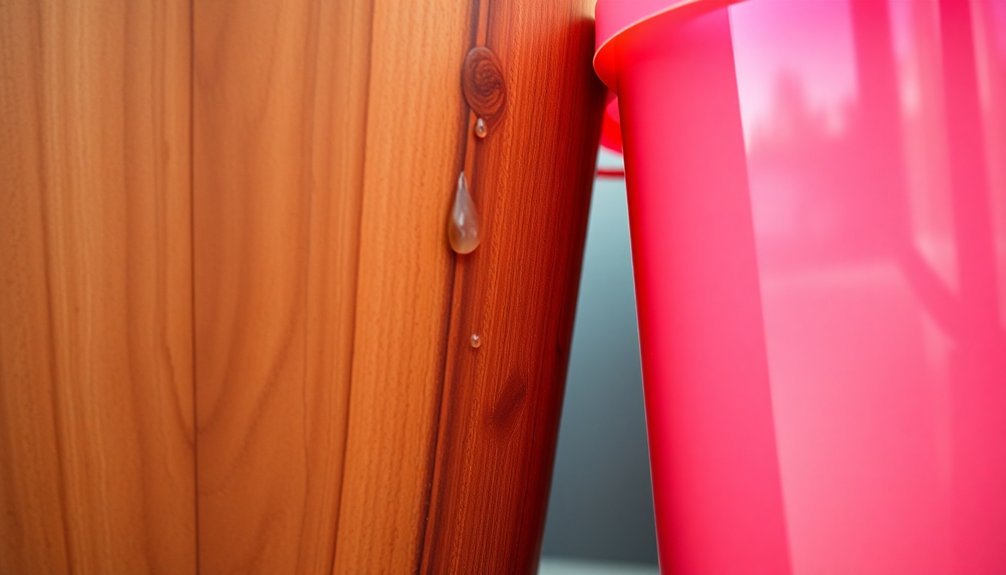
While both wood and plastic buckets serve as viable containers for soap curing, their material composition plays a minimal role in the actual curing process.
What matters most is ensuring proper air circulation around your soap, regardless of bucket choice.
Wood buckets might absorb slight moisture from curing soap, but this doesn't greatly impact the final product. The primary consideration should be ventilation – your soap needs to breathe to cure properly, requiring regular turning or an airy setup. The curing process typically takes 4 to 6 weeks for handmade soap to properly harden and reach optimal quality.
When deciding between materials, consider practicality. Plastic buckets are generally easier to clean, more durable, and less expensive.
Wooden options offer aesthetic appeal and environmental benefits if sustainably sourced.
Either way, you'll need to protect curing soap from direct sunlight and maintain a clean environment.
Comparing Heat Retention: Wood vs. Plastic in Gel Phase
Despite common misconceptions, neither wood nor plastic buckets excel naturally at heat retention for soap's gel phase. Both materials require additional insulation to maintain the heat necessary for achieving that desirable translucent appearance.
Neither wood nor plastic buckets naturally retain enough heat for soap's gel phase—both need added insulation for translucent results.
While wood molds are sometimes thought to retain heat better, they actually don't provide significant thermal advantages over plastic HDPE or PP buckets. Instead, your insulation strategy matters more than mold material.
Wrapping your mold in blankets, using a heating pad underneath, or employing the oven process method will be far more effective regardless of whether you've chosen wood or plastic. During saponification, proper insulation helps the soap reach temperatures of up to 180 °F in the gel phase.
Remember that larger molds generally retain heat better than smaller ones, and your choice of fragrance can also influence temperature during saponification.
For consistent gel phase results, focus on proper insulation rather than bucket material.
How Material Choice Affects Trace Development
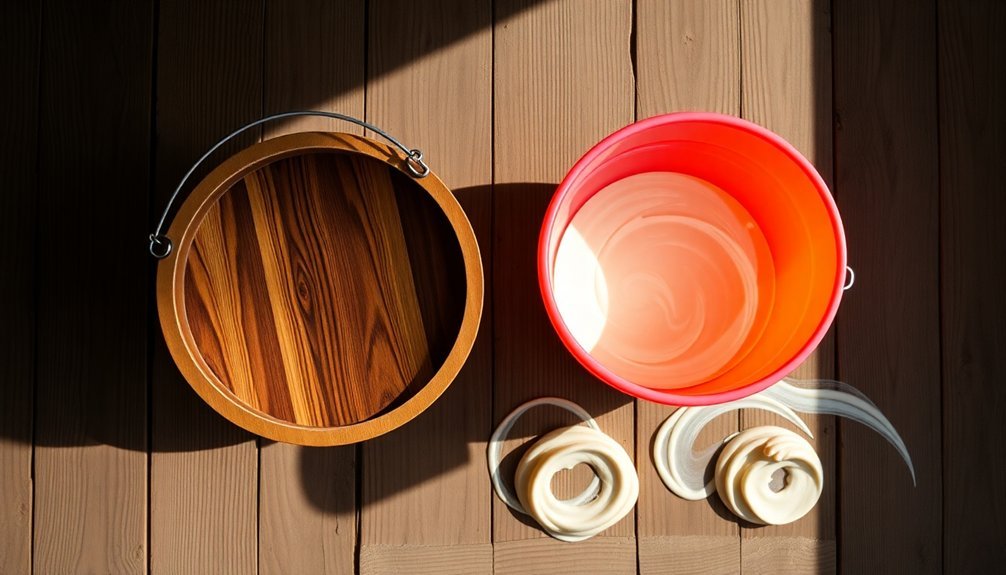
The relationship between bucket material and trace development is commonly misunderstood in soapmaking circles.
In reality, whether you're using wood or plastic buckets won't directly influence how your soap reaches trace. The chemical reaction of saponification happens independently of your container material.
Trace development—that pudding-like consistency when oils and lye properly emulsify—depends on your recipe, temperature, and mixing technique rather than your bucket material. Recognizing the different stages from very light trace to thick trace will help you determine when to add specific ingredients or pour into molds.
You'll observe trace forming just as effectively in either container type. False trace, when your mixture thickens prematurely due to cooling, isn't caused by your bucket choice but by temperature fluctuations in your soap mixture.
Focus instead on proper mixing techniques and maintaining appropriate temperatures for reliable trace development, regardless of whether you've chosen wood or plastic.
Durability Factors in Daily Soap Production
When you're making soap daily, your choice between wood and plastic buckets will be tested through hundreds of uses, with plastic typically enduring more cycles without degradation.
You'll find that plastic buckets offer superior resistance to lye, which gradually breaks down wooden vessels despite proper sealing.
While wooden buckets may crack under extreme temperature fluctuations, plastic containers can better withstand both hot and cold soap-making processes without compromising structural integrity. For commercial soap production, consider containers with load-rated capabilities that ensure safety during transportation and prevent product loss.
Impact of Repeated Use
Consistent soap production demands containers that withstand daily wear and tear, making durability an essential factor in your bucket selection.
With repeated use, you'll notice wooden buckets maintain their structural integrity better than plastic alternatives.
While plastic buckets might initially seem more convenient, they're prone to warping and cracking after multiple heat exposures.
In contrast, wooden buckets handle temperature fluctuations gracefully, though they'll require occasional maintenance to prevent moisture damage.
Wood molds can soften over time due to continuous exposure to raw soap components, affecting their durability in high-volume production settings.
You'll find wooden buckets can be repaired when damaged, unlike plastic which typically needs complete replacement.
This repairability, combined with wood's superior longevity, offers better long-term value despite the higher initial investment.
For high-volume production, wooden buckets provide the stability and heat retention needed while maintaining their form batch after batch.
Lye Resistance Comparison
Selecting containers with proper lye resistance ranks among the most important safety considerations in soap making.
You'll find that wood containers are fundamentally incompatible with lye—they absorb the caustic solution and react with it, quickly deteriorating and potentially compromising your soap batch.
For plastic options, HDPE (high-density polyethylene) offers excellent lye resistance, making it your best choice for both mixing and storage.
LDPE (low-density polyethylene) resists lye but softens with heat, making it unsuitable for the initial mixing process.
Avoid PET containers entirely as they break down when exposed to lye. Polypropylene (PP) containers are also highly recommended as they provide excellent resistance to alkaline solutions.
Similarly, PVC isn't recommended due to its chemical properties.
Always check container markings before use—the right material guarantees both your safety and successful soap production.
Temperature Handling Properties
Temperature control presents a critical challenge in soap making, with your choice between wood and plastic containers greatly impacting batch quality and production efficiency.
Wood molds offer superior insulation properties, maintaining consistent temperatures throughout the saponification process and facilitating better gel phase control. This natural insulation can potentially shorten curing times without additional heating requirements. Wrap-around silicone heaters can be used with larger containers to enhance the temperature management capabilities of both materials.
While wood requires periodic sealing and more storage space, it's generally more durable under heat conditions and less prone to warping over time.
HDPE plastic buckets, though more cost-effective and adaptable for smaller batches, can become brittle with prolonged heat exposure. They conduct heat more readily than wood, which affects temperature control in larger batches.
However, plastic provides more uniform heating throughout the soap and requires less maintenance overall.
Cost Analysis: Investment vs. Longevity in Bucket Selection
When choosing between wood and plastic buckets for soap making, you'll face a significant difference in initial investment, with wooden options costing more upfront but potentially saving money through their extended lifespan.
Your production volume will influence whether the replacement rate of less expensive plastic buckets outweighs the one-time investment in quality wooden vessels.
DIY wooden bucket options can reduce costs for crafty soap makers, while commercial plastic buckets offer standardization that might better suit businesses scaling their operations. Plastic options provide lightweight handling advantages similar to plastic dispensers, making them easier to maneuver during the soap-making process.
Initial vs. Lifetime Costs
Making a smart financial decision between wood and plastic buckets requires looking beyond just the price tag at checkout.
While plastic buckets initially cost less (around $35 for HDPE types), wooden buckets represent a higher upfront investment but potentially greater long-term value.
Consider how frequency of use affects your equipment needs.
Wood buckets typically outlast plastic ones when properly maintained, resisting chemical corrosion better over time. However, they'll require periodic sealing and more careful cleaning, adding to your maintenance costs. For new soap makers, this additional maintenance might be worth considering as part of your initial investment of $50-70.
Plastic buckets offer convenience with easier cleaning and minimal upkeep, but they're more prone to cracking under stress and showing wear sooner.
If you're making soap regularly, the durability of wood might justify its higher initial cost, while occasional soap makers might find plastic more economical.
Replacement Rate Considerations
Looking at how often you'll need to replace your soap making equipment reveals the true cost difference between wood and plastic options.
Wood buckets require more maintenance but can last for years when properly cared for with occasional oiling, potentially offsetting their higher initial cost.
Plastic buckets are cheaper upfront and resist lye well, but they're susceptible to warping and cracking over time. While you'll replace them more frequently, their affordability makes this less painful financially.
Consider that wood buckets might need liners but can be repaired when damaged, extending their useful life. Similar to wooden loaf moulds, they retain heat well during the soap-setting process, which can be beneficial for certain recipes.
Plastic offers convenience and easy cleaning but limited longevity. Your choice ultimately depends on whether you prefer the lower maintenance approach of replacing inexpensive plastic containers or investing in durable wood that requires more care.
DIY vs. Commercial Options
Soap makers often face the decision between crafting their own equipment or investing in commercial products. When weighing your options, consider that DIY molds offer complete customization for unique designs, while potentially saving money in the long run. For safety when using containers, always ensure you select stainless steel pots for mixing lye solutions rather than glass or aluminum materials.
| Aspect | DIY Molds | Commercial Molds |
|---|---|---|
| Cost | Lower initial investment | Higher upfront cost |
| Customization | Unlimited design options | Limited to available styles |
| Skill Required | Woodworking knowledge needed | No special skills required |
Creating your own wooden molds allows you to source materials locally or repurpose existing wood, contributing to sustainability efforts. Though they require woodworking skills to construct, the lifelong benefits of well-crafted DIY molds often outweigh the convenience of store-bought options, especially for small-scale soap makers committed to their craft.
Chemical Resistance Properties of Traditional Vessels
When selecting vessels for soap making, chemical resistance stands as the most critical property to evaluate.
Polypropylene (PP #5) plastic containers offer excellent resistance to lye and other alkalis, making them ideal for your soap-making process. You'll find they also resist moisture, grease, and various solvents used in additives.
Wood isn't suitable for soap making as lye degrades it quickly, creating safety hazards and contaminating your soap.
For metal options, only stainless steel provides the necessary resistance—aluminum, copper, and bronze react dangerously with lye.
Silicon and ceramic materials offer safe alternatives with good chemical resistance. Always label your containers properly and store them away from children to maintain a safe soapmaking environment.
Remember to pair your chosen vessel with nitrile gloves and proper ventilation to protect yourself from caustic substances and fumes during the soap-making process.
Storage Considerations for Different Batch Sizes
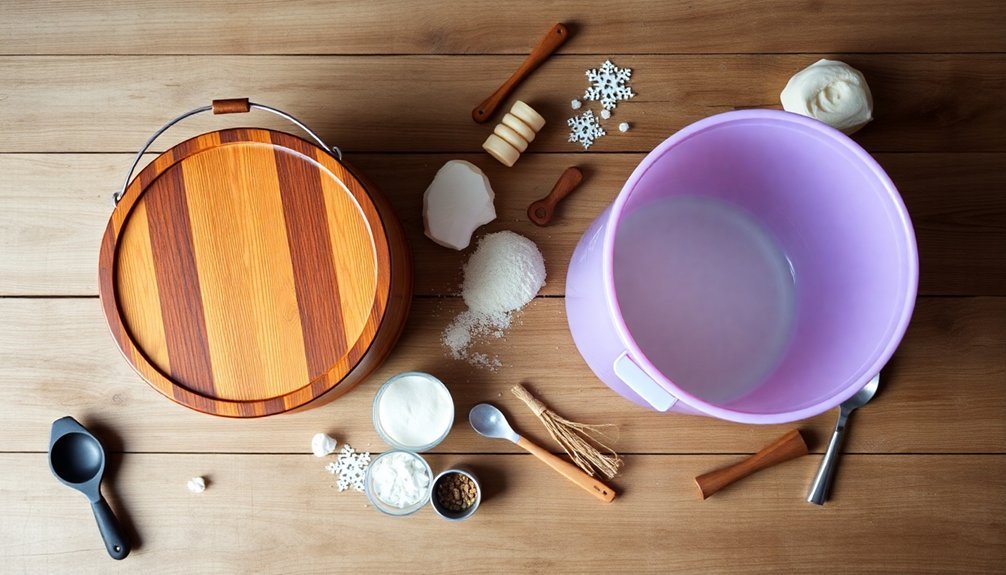
Choosing the right storage container size for your soap making depends heavily on your batch volume, with small operations typically requiring 2-5 gallon buckets that fit nicely in limited spaces.
As you scale up production, you'll need to shift to medium-sized 5-7 gallon containers or even larger plastic drums for batches exceeding 40 pounds. Many soapmakers find that Rubbermaid containers are ideal for dividing and storing prepped oils for individual batches.
You'll find plastic containers offer greater versatility across all production scales, allowing you to easily adapt your storage solutions as your soap making business grows.
Small-Batch Container Options
Efficiency matters greatly when selecting containers for small-batch soap making. When working with batches under 500g of oil, your container needs are considerably different from commercial production.
Small plastic containers coded #5 (polypropylene) are ideal for mixing ingredients, as they resist heat and alkali compounds without reacting with lye. For storage, stackable plastic buckets save valuable space while protecting your soaps from moisture.
If aesthetics are important to you, wooden containers offer visual appeal, though they're typically more expensive and less moisture-resistant than plastic alternatives.
Regardless of material choice, make sure your containers aren't aluminum, which reacts dangerously with lye. Starting with smaller containers allows you to practice various techniques while reducing financial risk associated with failed experiments.
For molding small batches, single-cavity molds or small loaf molds provide flexibility while remaining budget-friendly.
Remember to label each container clearly to track your different batches.
Bulk Production Storage
Three essential factors transform your soap storage approach when scaling to bulk production: ventilation, organization, and environmental control. When shifting from small-batch to bulk production, you'll need containers that facilitate airflow while maximizing your available space. Flipping soaps regularly ensures all sides receive equal exposure to air, which is crucial for proper curing and longevity.
| Storage Option | Ventilation | Cost-Effectiveness | Aesthetic Appeal |
|---|---|---|---|
| Plastic Bins | High (with holes) | Excellent | Functional |
| Wooden Crates | Moderate | Moderate | Rustic/Premium |
| Produce Boxes | Good | Budget-friendly | Industrial |
| Open Shelving | Excellent | Variable | Professional |
Maintain a cool, low-humidity environment away from direct sunlight to preserve soap quality. Use cheesecloth covers to protect from dust while allowing airflow. Remember to implement a clear labeling system to track production dates and ingredients efficiently, especially when managing multiple batches simultaneously.
Cleaning and Maintenance of Soap Making Containers
Proper cleaning of your soap making containers is essential for both safety and the quality of future batches. Start by wiping containers with paper towels to remove raw soap before washing. Never pour raw soap down drains as it causes clogs.
For lye-contaminated equipment, neutralize with vinegar solution while wearing protective gloves. Run stick blenders in hot water to clean blades effectively. If soap has hardened, use a scraper or knife to remove traces.
When choosing containers, remember that lye reacts with aluminum and can shatter glass. Opt for #5 plastic containers or stainless steel pots.
For easier cleanup, let equipment sit 24-48 hours to allow saponification, then wash thoroughly to prevent oily buildup. Always store clean equipment in dry areas to prevent mold growth. This overnight waiting approach is safer as the caustic lye transforms into soap, eliminating the risk of burns and drain damage.
Environmental Impact of Wood and Plastic Soap Vessels
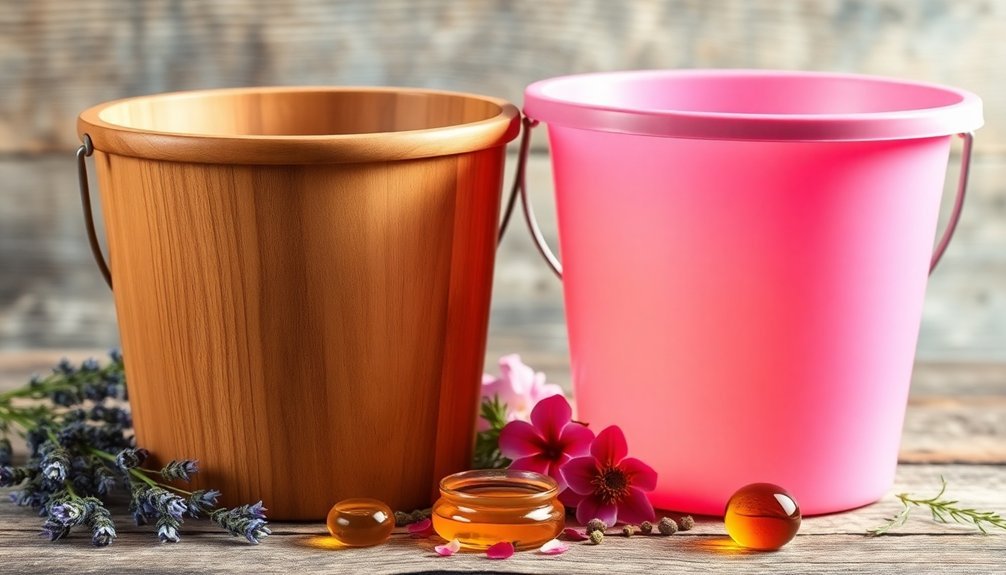
When selecting materials for your soap making containers, the environmental implications deserve careful consideration alongside practical factors.
Wood offers significant ecological advantages as a renewable resource that acts as a carbon sink throughout its lifecycle. It requires less energy to produce and biodegrades naturally when discarded.
In contrast, plastic buckets derive from non-renewable fossil fuels and generate higher carbon emissions during manufacturing. Though durable and practical for soap making, plastic's environmental footprint extends long after use, contributing to waste accumulation and ecosystem disruption.
Your choice reflects broader sustainability values. While plastic offers convenience and lower initial costs, wood represents a commitment to reduced environmental impact. A comprehensive life-cycle assessment would be necessary to accurately compare the total greenhouse gas emissions between wood and plastic soap making vessels.
Consider whether locally sourced wooden vessels might align with your soap making philosophy despite requiring more maintenance.
Traditional Aesthetics vs. Modern Practicality in Soap Crafting
The art of soap making beautifully illustrates the tension between traditional aesthetics and modern practicality. When you choose wood molds, you're investing in a professional, rustic look that appeals to customers who value natural aesthetics. These thermal insulators guarantee consistent gel phase and, with proper care, become long-term crafting companions.
Conversely, plastic molds offer undeniable convenience. They're cost-effective, lightweight, and come in diverse shapes that simplify the process, especially for beginners. Their easy-to-clean surfaces reduce maintenance hassles while still providing flexibility in your soap designs.
Your choice ultimately depends on your priorities: wood delivers artisanal craftsmanship and traditional appeal while accommodating larger batches, whereas plastic provides practical efficiency and creative versatility for those focusing on production speed and diverse offerings.
Safety Profiles: Lye Compatibility With Different Materials

Understanding which materials safely withstand lye exposure stands as perhaps the most critical safety consideration in soap making.
When working with sodium hydroxide, your material choices can mean the difference between safety and disaster.
Polypropylene (PP#5) is your best option, offering excellent alkali resistance even at high temperatures.
High-density polyethylene (HDPE#2) works for cooled lye solutions but may soften when hot.
Pure stainless steel containers are safe, provided they contain no aluminum alloys.
Never use aluminum—it reacts violently with lye, potentially releasing explosive hydrogen gas.
Avoid glass containers which etch and weaken over time, and steer clear of PET, PVC, copper, iron, tin, and Teflon-coated utensils.
Particularly problematic are plastic foams which can deteriorate rapidly and contaminate your soap mixture when exposed to strong alkalis.
These materials degrade quickly when exposed to alkali, compromising both your safety and soap quality.
Adapting Historical Soap Making Vessels for Modern Techniques
Throughout centuries of soap making history, artisans relied on wooden buckets and clay vessels that modern crafters can still adapt for contemporary methods.
You'll find these traditional containers impart unique scents and characteristics to your soap that plastic simply can't replicate.
When adapting historical vessels, you'll need to properly oil wooden buckets to prevent drying and cracking.
For hot process techniques, insulate your wooden vessels carefully to maintain temperature control—a challenge compared to modern plastic alternatives.
While wood requires more maintenance, it offers authenticity and craftsmanship that many artisanal soap makers value.
The strength of traditional lye extracted from hardwood ash often varied widely, making ash hoppers a critical tool for early soap makers trying to achieve consistent results.
The key to successful adaptation lies in combining traditional materials with modern understanding of temperature control and chemical reactions, allowing you to honor historical techniques while achieving consistent quality in your finished soaps.
Frequently Asked Questions
Can Buckets Be Repurposed for Other Crafting Activities After Soap Making?
Yes, you can repurpose soap buckets for crafting activities once properly cleaned. They're great for art projects, flower arrangements, storage solutions, and garden plants. Remember to remove all soap residue first.
How Do Different Wood Types Affect Soap Quality and Curing Time?
Cedar can accelerate curing by creating a slightly acidic environment. You'll notice pine may add subtle scents to your soap. Be cautious, as porous woods can absorb lye, affecting your soap's hardness and consistency.
Do Seasonal Temperature Changes Affect Bucket Material Selection?
Yes, they do! You'll want plastic in extreme heat as wooden buckets may crack. In cold weather, wood provides better insulation for proper curing. Always consider your climate when selecting your soap making containers.
Can Additives Like Essential Oils Damage Certain Bucket Materials?
Yes, essential oils can damage certain bucket materials. They'll dissolve non-resistant plastics quickly and potentially stain wood. You should use glass, stainless steel, or HDPE containers when working with these potent additives.
Are There Regional Preferences for Bucket Materials Among Soap Makers?
You'll find regional preferences vary based on accessibility and economic factors. Areas with abundant wood may prefer wooden buckets, while regions with strong environmental awareness or high wood costs might choose differently.
In Summary
Whether you're a traditional soap artisan or modern maker, your bucket choice matters. Wood offers superior heat retention and aesthetic appeal but requires more maintenance and investment. Plastic provides practicality, affordability, and chemical resistance while sacrificing some traditional benefits. Consider your production scale, environmental values, and soap techniques when deciding. Ultimately, many successful soap makers maintain both options in their studios for different applications.

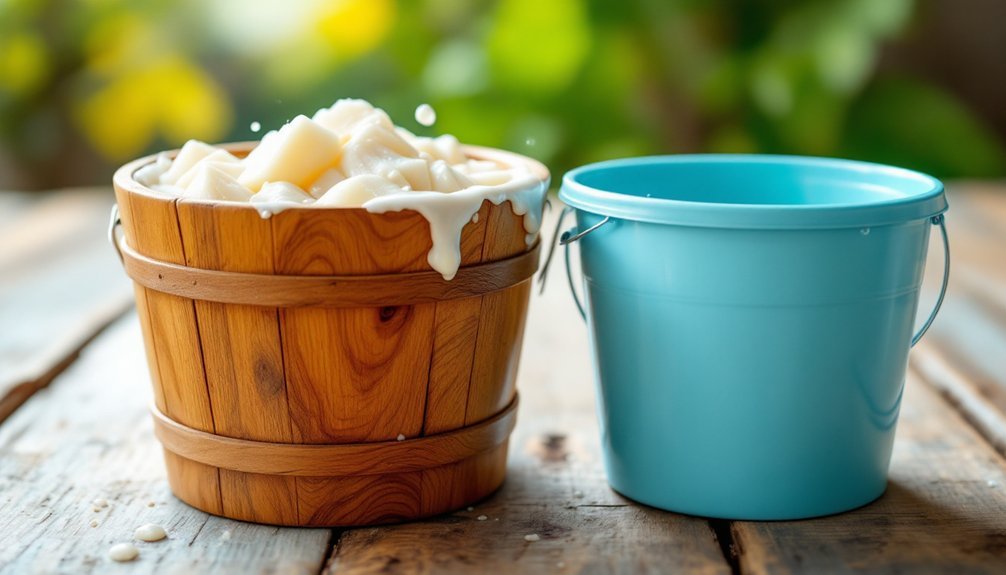



Leave a Reply